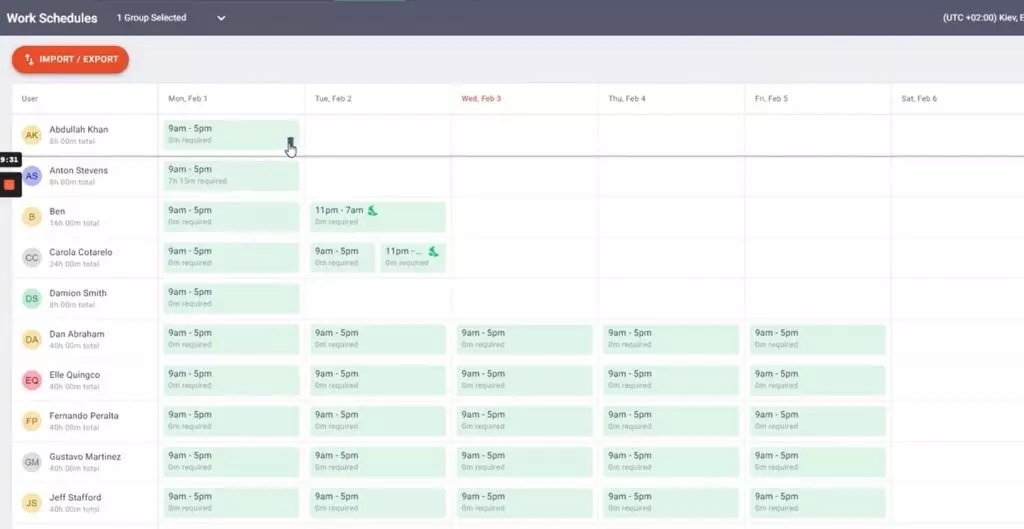Even though remote work isn’t a new idea, it’s something that most people had little experience with before 2020.
Before the onset of the COVID-19 pandemic, only 6% of the workforce worked from home the majority of the time. And a staggering 75% never worked from home at any point in their careers.
But by the height of the pandemic, more than a third of people were working from home full-time. That represents more than a fivefold increase compared to pre-pandemic levels. And all of it happened in a matter of a few months – and under some of the toughest conditions imaginable.
People soon began to speculate that work-from-home (WFH) would become the new normal. Studies showed that the workforce dreaded the day they’d have to return to work. But that didn’t last long.
By the end of the year, the novelty of full-time WFH started to wear off. Employees started to show signs of stress resulting from their new working arrangements. And one by one, businesses that had started to consider making WFH permanent began to temper their enthusiasm. And now, nobody’s quite sure what’s going to happen next.
Businesses will continue in some capacity to support remote workers, however. Some will adopt hybrid work schedules that see employees spitting their time between home and the office. Others may extend WFH privileges to all who prefer them.
Ten of the biggest lessons learned from working from home
Let’s review some of the lessons businesses learned from working from home in the past two years.
Hopefully, these lessons will help them make the most of whatever level of WFH they eventually settle on.
Lesson one: Purposeful communication is the key to WFH success
The first thing businesses realized when switching to a remote mode of working was how much they relied on informal office communication.
Whether it was employees stopping by their colleagues’ desks to ask questions or managers pulling team members aside to discuss details of a project, all of this was ended when workers went home.
And it created immediate communications issues that needed solutions.
Some businesses tried to replicate their in-office communication norms using pre-scheduled standups and video chat meetings. Most quickly discovered that replicating the in-office experience was a waste of time and did not solve any problems. What they needed was purpose-built solutions designed with remote teams in mind.
The good news is that there wasn’t a shortage of those. Businesses that adopted solutions like Microsoft Teams, Slack, and Zoom right away found replacing informal communication far easier. It was also more productive to communicate this way as well.
Water cooler chats became part of dedicated Slack channels. Scheduled unstructured time created plentiful opportunities for quick asides between managers and team members.
All this indicates that there are equally effective modes of communication for remote workers as traditional inter-office communication. Businesses must select the right tools and make them available to all of their remote workers in order to succeed with WFH.
Lesson two: Scheduling is more complex for all-remote teams
Although most workers aren’t thrilled with the rigid, nine-to-five nature of traditional in-office work, it does have advantages. And one of those is simplified scheduling. In the office, for example, it’s simple to have morning stand-ups because everyone arrives at work by a specific time.
But part of the lure of WFH is the enhanced flexibility it offers to workers. When they work from home, they don’t necessarily need to sit at a desk every moment of the day to stay productive. And especially during the pandemic, many workers had to tend to family obligations that made keeping regular hours difficult, if not impossible.

And as it turns out, that’s not a bad thing. It just meant that businesses had to work a little harder to build work schedules that worked for everyone. And again, using the right tools helped a great deal. Businesses could turn to solutions like Time Doctor to create, manage, and track employee schedules no matter how complex they were. It meant workers could make their work fit into their life, instead of the other way around. And that proved to be great for businesses and employees alike.
Lesson three: WFH can destroy company culture, but it doesn’t have to
When workers first took to working from home in early 2020, most people loved the change. But soon, the situation started to wear on a great many of them. Part of the reason was how tremendously isolating it can be to spend the majority of your time working alone.
Businesses – at least at first – underestimated how much of an effect the situation would have. And the effect was massive. According to surveys conducted by TinyPulse, the top two impacts reported by workers after a year of WFH were emotional exhaustion and reduced engagement. And those two things are a recipe for company culture disaster.
But plenty of businesses found ways to mitigate those effects. Most developed some form of virtual team-building strategies and made them a part of regular work schedules. Some held regular virtual social gatherings that allowed employees to come together and share the struggles and triumphs of their WFH experience. And others tasked managers with providing emotional support via increased interactions and had them make a visible commitment to transparency.
The lesson is that WFH will place a strain on workers and can cause company culture to degrade over time. But it’s not impossible to counteract those effects. All it takes is a directed effort toward that end and some adjustments to management style and employee support.
Lesson four: It’s important to teach employees to disconnect
In a normal office environment, it’s not uncommon to see an employee or two working extra hours when they need to catch up on their work. And traditional business culture tends to celebrate such conscientious employees. But the last year and a half of WFH caused a strange thing to happen: it turned almost everyone into workaholics.
According to data collected by the National Bureau of Economic Research, the past year saw workers putting in an average of 48.5 minutes of extra work each day. That may not sound like much, but it’s significant because it points to a broader trend of employees having difficulty disconnecting from their jobs at the end of the day. Without a physical boundary between their work lives and their home lives, many struggled to keep them separate.
In the long run, that’s not a healthy trend. And it means that employers are going to have to find ways to encourage their employees to disconnect when the official workday ends. To a certain extent, managers can do this by keeping better track of employees’ time and reminding them not to overdo it.
Or, to preserve the flexibility that makes WFH such a desirable option, employers can tally those extra hours and add them to each employee’s paid vacation time. But they’d also have to make taking time off at certain intervals mandatory to make that work.
Lesson five: WFH burnout is a very real threat to productivity
Employees working longer hours wasn’t the only consequence of the sudden shift to WFH. There’s also evidence that the blurred lines between work and home fed a wave of employee burnout during the past year and a half. And as burnout increased, productivity fell.
A survey by employment platform Monster.com found that 69% of employees began showing symptoms of burnout by July of 2020. That’s just a little over 5 months after the big shift to WFH began. And right around the same time, productivity – which spiked in the early days of WFH – dropped by 14%.

Although it’s possible to write those simultaneous findings off as mere coincidence, no business that wants to succeed with WFH can afford to do so. The takeaway is that WFH burnout is real and will drain worker productivity if left unchecked.
But fixing the problem is a simple matter of developing adequate workload management strategies and putting them into effect. And with the contributors to burnout in check, applying some tried-and-true remote productivity strategies should help most businesses reclaim their early WFH productivity gains.
Lesson six: WFH isn’t for everyone
At the beginning of the pandemic, news outlets overflowed with stories about how much everyone loved working from home. But some of that sentiment had more to do with their relief at still receiving a steady paycheck while other people faced unemployment than it did with their new working conditions. And on top of that, a certain amount of a “we’re all in this together” spirit papered over the dissatisfaction some employees felt.
And today, surveys on the subject tell a very different tale. At last count, 66% of employees reported feeling anxious to get back to their offices. And their reasoning paints a picture of a workforce divided over the benefits of WFH. Many reported missing the opportunity to socialize with coworkers, while others missed the perks their employers offered at the office. In other words, they’d happily give up flexible scheduling for some pre-pandemic normalcy.
The fact that more than half of employees don’t want to continue working from home means most businesses won’t be well-served by going all-remote for good. There are simply some workers that can’t handle it. This means it’s a good idea for businesses to conduct in-depth surveys on the subject before making any long-term decisions about how to proceed.
Lesson seven: HR is more important than ever
Given the immense challenges that workers faced in transitioning to full-time WFH, it’s no surprise that most businesses leaned hard on their HR departments for all kinds of help. HR professionals had to lend their support to workers trying to navigate their new work/life balance. They had to stand up for new employee support programs to help them deal with the stress of the pandemic and the isolation it caused. And they served as a vital bridge that connected employees together into a single cohesive workforce.
And as the strain of WFH started to show itself, HR professionals were the ones to sound the alarm to business decision-makers. Going forward, any extension of WFH – either through hybrid work arrangements or opt-in programs – will depend on HR departments’ ability to help employees adapt. And that means businesses may need to devote more resources to their HR departments or reorganize them to handle the work to come.
Those efforts will necessarily include enlisting HR’s help in developing permanent remote work policies. And the same goes for designing new, remote-centric onboarding processes. For businesses that wish to make WFH a permanent part of their operations, the past year and a half demonstrated that success runs through the HR department – for both the business and employees alike.
Lesson eight: Remote meetings are hard, hybrid meetings will be harder
By now, it’s difficult to find anyone in the workforce that hasn’t participated in a meeting via Zoom or some other video conferencing platform at some point in the last year and a half. And at first, it worked well. People saw the meetings as a way to work through the difficulties of the sudden WFH shift while staying connected to their coworkers.
But before long, remote meetings started to wear on everyone. And that’s when a new concept leaped into the public consciousness: Zoom fatigue.
It happened because videoconferencing platforms weren’t designed for people to use them near-constantly for months on end. And it didn’t help that many businesses decided to try and replicate their in-office meeting schedules via video instead of adapting them to the new environment.
Eventually, though, smart managers worked to cut down on unnecessary virtual meetings and the situation improved somewhat. But the fact remained that getting the hang of virtual meetings was a challenge that nobody saw coming. And the same thing will likely happen to the businesses moving to hybrid meetings when some of their employees return to the office.

That’s because even if it’s unintentional, people tend to focus more on those sharing space with them. That will give the voices of meeting attendees in the office more weight than those of their remote counterparts. And that’s bad for a variety of reasons. But businesses that see the problem coming can take steps to head off the problem. And by doing so they can avoid an unnecessary repeat of their earlier WFH meeting missteps.
Lesson nine: WFH is a massive cybersecurity challenge
As strange as it sounds, one of the very things that made mass WFH possible is also something that could turn it into a major threat to business viability. Years ago, only the largest corporations had the infrastructure necessary to support workers on the road. And even for them, the practice wasn’t widespread.
But the internet changed that. Today, even the smallest businesses can connect workers together at great distances, giving them all access to shared resources, data, and technology. It also introduced a kind of risk that businesses never had to face before, in the form of major new cybersecurity threats.
During the pandemic, those threats multiplied at an alarming rate. And there’s no doubt that the primary driver of the increase was the shift to WFH. One study found that 74% of recent cyberattacks on businesses happened due to security flaws introduced by remote work technology.
In many cases, cybercriminals bought official-sounding domain names and set up credential harvesting pages to trick employees into divulging sensitive data. Indeed, instances of cybersquatting rose sharply in the early months of the pandemic, leaving many businesses scrambling to inform employees of the threat – while simultaneously trying to secure alternate domain names to carry on with legitimate business functions.
Correcting those security oversights will be a primary challenge for businesses going forward, no matter how much or how little remote work they plan to allow in the future. The fact is that the shift to WFH exposed flaws in the cybersecurity assumptions most businesses made in the past, which will continue to plague those that don’t correct them.
Learn more about critical considerations with regard to cybersecurity for remote workers.
Lesson ten: Working from home is no longer optional
The final lesson that businesses learned – and continue to learn is that they’re going to have to retain some level of flexibility if they want to remain competitive going forward.
Right now, just about every business is facing a hiring crunch. And although there are a variety of reasons for it, there’s one that stands out –
Now that most workers have experienced work from home, they’re no longer willing to settle for a job without it.
And this is a lesson that businesses should have seen coming long before the pandemic forced their hands. A survey by Deloitte found that an astounding 94% of white-collar workers wanted to be able to work from home and have flexible hours. This was before the pandemic began. Consequently, it’s no wonder businesses are struggling to hire and retain employees in the midst of uncertainty over their future plans.
The data on the subject is compelling. Up to a third of workers now working from home would look for a new job if their employer demanded they return to the office. And right now, there’s every reason to believe that a significant number of workers are following through on that threat – fueling a new trend called the Great Resignation.
Under those circumstances, it’s clear that WFH is no longer something that businesses can treat as optional. It’s something they’ll have to embrace for the long term. Otherwise, they’ll have a hard time attracting and retaining top talent.
The bottom line
Going forward, businesses face some consequential decisions about how – and whether – to embrace WFH for the long term. Some might find their employees overwhelmingly receptive to the idea. Others might have a workforce that prefers a more conventional in-office workstyle.
But shifting labor dynamics all but guarantee that work from home is going to have to be a part of every company’s plans sooner or later. As for how they implement it, that’s a topic for a different article. But one thing’s for sure – the great pandemic WFH experiment yielded some critical lessons that businesses should keep in mind as they move forward.
Altogether, there are simply too many reasons that businesses should embrace WFH, and there are available solutions for most of the potential problems it creates. That said, only time will tell what the future of WFH will be. But the clock is most certainly already ticking.

Ivan Serrano is an enthusiastic writer who enjoys learning whatever he can about business development and growth hacking. He also enjoys sharing his knowledge of technology and how it can improve business communications on an international level.


